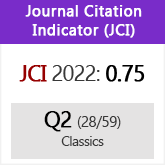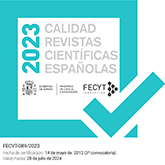Conceptual Metonymies and Metaphors with manus in Latin Drama
DOI:
https://doi.org/10.3989/emerita.2022.06.2117Keywords:
Latin linguistics, Cognitive Semantics, embodiment, dext(e)ra, laeuaAbstract
The main goal of this article is to describe and structure, from the Conceptual Metaphor Theory point of view, the contexts in which the word manus ‘hand’ is figuratively used in the Latin drama, through the description of their underlying conceptual metonymies and metaphors.
Downloads
References
Adams, J. N. (1982): «Anatomical Terms Used pars pro toto in Latin», The Proceedings of the African Classical Associations 16, pp. 37-45.
Barcelona, A. (2003): «Metonymy in Cognitive Linguistics: An Analysis and a Few Modest Proposals», en Cuyckens, H., Berg, T., Dirven, R. y Panther, K. U. (eds.), Motivation in Language: Studies in Honor of Gunter Radden, Ámsterdam- Filadelfia, John Benjamins, pp. 223-255. https://doi.org/10.1075/cilt.243.15bar
Barcelona. A. (2012). «La metonimia conceptual», en Ibarretxe-Antuñano, I. y Valenzuela, J. (eds.), Lingü.stica cognitiva, Barcelona, Anthropos, pp. 123-146.
Beekes, R. S. P. (1994): «'Right', 'Left' and 'Naked' in Indo-European», Orbis 37, pp. 87-96. https://doi.org/10.2143/ORB.37.0.2012766
Bekaert, E. (2009): Análisis de las metáforas y metonimias relativas a cinco partes del cuerpo esenciales: El ojo, la oreja, la nariz, la boca y la mano, Trabajo fin de máster, Gante, Universiteit Ghent, https://lib.ugent.be/en/catalog/rug01:001414041 (27/05/2021).
Billioti de Gage, C. (2012): Hands and Manipulations in the Grammar and Cognitive systems of English, Tesis Doctoral, Burdeos, Michel de Montaigne-Bordeaux III, https://tel.archives-ouvertes.fr/tel-00734308/document (27/05/2021).
Casasanto, D. (2009): «Embodiment of Abstract Concepts: Good and Bad in Right and Left-Handers», Journal of Experimental Psychology: General 138 (3), pp. 351-367. https://doi.org/10.1037/a0015854 PMid:19653795
Castaño, E., Gilboy, E., Feijóo, S., Serrat, E., Rostan, C., Hilferty, J. & Cunillera, T. (2018): «Hand Position and Response Assignment Modulate the Activation of the Valence-Space Conceptual Metaphor», Cognitive Science 42 (7), pp. 2342-2363. https://doi.org/10.1111/cogs.12669 PMid:30101555
Corpas, G. (1996): Manual de fraseología española, Madrid, Gredos.
Croft, W. A. & Cruse, D. A. (2004): Cognitive Linguistics, Cambridge, Cambridge University Press. https://doi.org/10.1017/CBO9780511803864
Dirven, R. (2003): «Metonymy and Metaphor: Different Mental Strategies of Conceptualisation», en Dirven, R. y Pörings, R. (eds.), Metaphor and Metonymy in Comparison and Contrast, Berlín-Nueva York, Mouton de Gruyter, pp. 75-111. https://doi.org/10.1515/9783110219197.1.75
Fan, H. (2017): «A Study of 'Hand' Metaphors in English and Chinese. Cognitive and Cultural Perspective», Advances in Literary Study 5, pp. 84-93. https://doi.org/10.4236/als.2017.54007
Fedriani, C. (2011): «Experiential Metaphors in Latin: Feelings Were Containers, Movements and Things Possessed», Transactions of the Philological Society 109 (3), pp. 307-326. https://doi.org/10.1111/j.1467-968X.2011.01284.x
Fedriani, C. (2016): «Ontological and Orientational Metaphors in Latin: Evidence from the Semantics of Feelings and Emotions», en Short, W. M. (ed.), Embodiment in Latin Semantics, Ámsterdam-Filadelfia, John Benjamins, pp. 115-140. https://doi.org/10.1075/slcs.174.05fed
García Jurado, F. & López Gregoris, R. (1995), «Las metáforas de la vida cotidiana en el lenguaje plautino como procedimiento de caracterización de los personajes », Studi italiani di filologia classica 13 (2), pp. 233-245.
Goossens, L. (2003): «Metaphtonymy: The Interaction of Metaphor and Metonymy in Expressions for Linguistic Action», en Dirven, R. y Pörings, R. (eds.), Metaphor and Metonymy in Comparison and Contrast, Berlín-Nueva York, Mouton de Gruyter, pp. 349-377.
Hyun Jung, A. & Yeon Jin, K. (2007): «A Study on Metaphor and Metonymy of Hand», Journal of Language Sciences 14 (2), pp. 195-215.
Lakoff, G. (1987): Women, Fire and Dangerous Things: What Categories Reveal about the Mind, Chicago, University of Chicago Press. https://doi.org/10.7208/chicago/9780226471013.001.0001
Lakoff, G. & Johnson, M. (2018): Metáforas de la vida cotidiana, traducción de Carmen González Marín, Madrid, Cátedra.
Lakoff, G. & Turner, M. (1989): More than Cool Reason: A Field Guide to Poetic Metaphor, Chicago, University of Chicago Press. https://doi.org/10.7208/chicago/9780226470986.001.0001
Marco Simón, F. (1986): «Topografía cualitativa en la magia romana», Memorias de historia antigua 7, pp. 81-90.
Membrez, G. (2019): «Metaphor by Any Other Name. A Cognitive Linguistic Reassessment of Aristotle's Theory of Metaphor», en Mocciaro E. y Short, W. M. (eds.), Toward a Cognitive Classical Linguistics. The Embodied Basis of Constructions in Greek and Latin, Varsovia-Berlín, De Gryuter, pp. 207-227. https://doi.org/10.1515/9783110616347-009
Mendózar Cruz, J. (2020): «Las construcciones con verbo soporte en latín. Estado de la cuestión», Tempus 47, pp. 7-48.
Mocciaro, E. & Short, W. M. (eds.) (2019): Toward a Cognitive Classical Linguistics. The Embodied Basis of Constructions in Greek and Latin, Varsovia-Berlín, De Gryuter. https://doi.org/10.1515/9783110616347
Perbellini, M. (2010): «Metáforas y colocaciones», en Castillo Carballo, A. M. y García Platero, J. M. (eds.), La lexicografía en su dimensión teórica, Málaga, Universidad de Málaga, pp. 495-518.
Radden, G. & Kövecses, Z. (1999): «Towards a Theory of Metonymy», en Panther, K. U. y Radden, G. (eds.), Metonymy in language and thought, Ámsterdam- Filadelfia, John Benjamins. https://doi.org/10.1075/hcp.4.03rad
Ribbeck, O. (1897): Scaenicae Romanorum poesis fragmenta, Leipzig, Teubner.
Short, W. M. (2016a): «Spatial Metaphors of Time in Roman Culture», Classical World: A Quarterly Journal on Antiquity 109 (3), pp. 381-412. https://doi.org/10.1353/clw.2016.0038
Short, W. M. (ed.) (2016b): Embodiment in Latin Semantics, Ámsterdam-Filadelfia, John Benjamins.
Stepien, M. A. (2007): «Metáfora y metonimia conceptual en la fraseología de cinco partes del cuerpo humano en español y polaco», Anuario de estudios filológicos 30, pp. 391-409.
Tarriño Ruiz, E. (2021): «El adjetivo», en Baños, J. M. (coord.), Sintaxis latina, vol. 1, Madrid, CSIC, pp. 271-300.
Tur, C. (2020): «Una aproximación a la enseñanza de las colocaciones latinas a través de metáforas cognitivas», Estudios Clásicos 158, pp. 123-140.
Unceta Gómez, L. (2012), «Metáforas para pensar. Los verbos latinos de 'pensamiento' y 'opinión' desde un enfoque diacrónico estructural», en Martínez del Castillo, J. (coord.), Eugenio Coseriu (1921-2002) en los comienzos del siglo XXI, Málaga, Analecta Malacitana, pp. 169-185.
Downloads
Published
How to Cite
Issue
Section
License
Copyright (c) 2022 Consejo Superior de Investigaciones Científicas (CSIC)

This work is licensed under a Creative Commons Attribution 4.0 International License.
© CSIC. Manuscripts published in both the printed and online versions of this Journal are the property of Consejo Superior de Investigaciones Científicas, and quoting this source is a requirement for any partial or full reproduction.All contents of this electronic edition, except where otherwise noted, are distributed under a “Creative Commons Attribution 4.0 International” (CC BY 4.0) License. You may read here the basic information and the legal text of the license. The indication of the CC BY 4.0 License must be expressly stated in this way when necessary.
Self-archiving in repositories, personal webpages or similar, of any version other than the published by the Editor, is not allowed.














